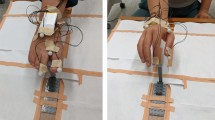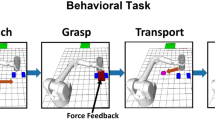Abstract
Recent evidence suggests that the mirror neuron system responds to the goals of actions, even when the end of the movement is hidden from view. To investigate whether this predictive ability might be based on the detection of early differences between actions with different outcomes, we used electromyography (EMG) and motion tracking to assess whether two actions with different goals (grasp to eat and grasp to place) differed from each other in their initial reaching phases. In a second experiment, we then tested whether observers could detect early differences and predict the outcome of these movements, based on seeing only part of the actions. Experiment 1 revealed early kinematic differences between the two movements, with grasp-to-eat movements characterised by an earlier peak acceleration, and different grasp position, compared to grasp-to-place movements. There were also significant differences in forearm muscle activity in the reaching phase of the two actions. The behavioural data arising from Experiments 2a and 2b indicated that observers are not able to predict whether an object is going to be brought to the mouth or placed until after the grasp has been completed. This suggests that the early kinematic differences are either not visible to observers, or that they are not used to predict the end-goals of actions. These data are discussed in the context of the mirror neuron system.




Similar content being viewed by others
References
Ansuini C, Santello M, Massaccesi S, Castiello U (2006) Effects of end-goal on hand shaping. J Neurophysiol 95:2456–2465
Armbrüster C, Spijkers W (2006) Movement planning in prehension: do intended actions influence the initial reach and grasp movement? Mot Control 10(4):311–329
Begliomini C, Caria A, Grodd W, Castiello U (2007) Comparing natural and constrained movements: new insights into the visuomotor control of grasping. PLoS ONE 2(10):e1108. doi:10.1371/journal.pone.0001108
Blake R, Shiffrar M (2007) Perception of human motion. Ann Rev Psychol 58:47–73
Brainard DH (1997) The psychophysics toolbox. Spat Vis 10(4):433–436
Bremner AJ, Cowie D (in press) Developmental origins of the hand in the mind, and the role of the hands in the development of the mind. In: Radman Z (ed) The hand: Organ of the mind. Cambridge: MIT Press
Cheng Y, Meltzoff AN, Decety J (2007) Motivation modulates the activity of the human mirror-neuron system. Cereb Cortex 17(8):1979–1986
Cohen RG, Rosenbaum DA (2004) Where grasps are made reveals how grasps are planned: generation and recall of motor plans. Exp Brain Res 157(4):486–495
Costello AB, Osborne JW (2005) Best practices in exploratory factor analysis: four recommendations for getting the most from your analysis 10(7): 1–9
de Vaus DA (2002) Analyzing social science data. Sage Publications, London
Desmurget M, Grafton ST (2000) Forward modeling allows feedback control for fast reaching movements. Trends Cogn Sci 4(11):423–431
di Pellegrino G, Fadiga L, Fogassi L, Gallese V, Rizzolatti G (1992) Understanding motor events: a neurophysiological study. Exp Brain Res 91(1):176–180
Eastough D, Edwards MG (2007) Movement kinematics in prehension are affected by grasping objects of different mass. Exp Brain Res 176(1):193–198
Fadiga L, Fogassi L, Pavesi G, Rizzolatti G (1995) Motor facilitation during action observation: a magnetic stimulation study. J Neurophysiol 73(6):2608–2611
Ferrari PF, Gallese V, Rizzolatti G, Fogassi L (2003) Mirror neurons responding to the observation of ingestive and communicative mouth actions in the monkey ventral premotor cortex. Eur J Neurosci 17(8):1703–1714
Fikes TG, Klatzky RL, Lederman SJ (1994) Effects of object texture on precontact movement time in human prehension. J Mot Behav 26(4):325–332
Flatters IJ, Otten L, Witvliet A, Henson B, Raymond JH, Culmer P, Bingham GP, Wilkie RM, Mon-Williams M (2012) Predicting the effect of surface texture on the qualitative form of prehension. PLoS ONE 7(3):e32770. doi:10.1371/journal.pone.0032770
Fogassi L, Ferrari PF, Gesierich B, Rozzi S, Chersi F, Rizzolatti G (2005) Parietal lobe: from action organization to intention understanding. Science 308:662–667
Iacoboni M, Woods RP, Brass M, Bekkering H, Mazziotta JC, Rizzolatti G (1999) Cortical mechanisms of human imitation. Science 286(5449):2526–2528
Manera V, Becchio C, Cavallo A, Sartori L, Castiello U (2011) Cooperation or competition? Discriminating between social intentions by observing prehensile movements. Exp Brain Res 211(3–4):547–556
Marteniuk RG, Mackenzie CL, Jeannerod M, Athenes S, Dugas C (1987) Constraints on human arm movement trajectories. Can J Psychol 41(3):365–378
Mon-Williams M, Bingham GP (2011) Discovering affordances that determine the spatial structure of reach-to-grasp movements. Exp Brain Res 211:145–160
Pryde KM, Roy EA, Campbell K (1998) Prehension in children and adults: the effects of object size. Hum Mov Sci 17:743–752
Rizzolatti G, Craighero L (2004) The mirror-neuron system. Ann Rev Neurosci 27:169–192
Rochat P (1993) Hand-mouth coordination in the newborn: Morphology, determinants, and early development of a basic act. In: Savelsbergh GJP (ed) The development of coordination in infancy. Elsevier, Amsterdam, pp 265–288
Runeson S, Frykholm G (1983) Kinematic specifications of dynamics as an informational basis for person-and-action perception: Expectation, gender recognition, and deceptive intention 112: 585–615
Sartori L, Cavallo A, Bucchioni G, Castiello U (2011a) Corticospinal excitability is specifically modulated by the social dimension of observed actions. Exp Brain Res 211(3–4):557–568
Sartori L, Straulino E, Castiello U (2011b) How objects are grasped: the interplay between affordances and end-goals. PLoS ONE 6(9):e25203. doi:10.1371/journal.pone.0025203
Schuboe A, Maldonado A, Stork S, Beetz M (2008) Subsequent actions influence motor control parameters of a current grasping action. In: The 17th IEEE international symposium on robot and human interactive communication, 2008. RO-MAN 2008, pp 389–394
Sebanz N, Shiffrar M (2007) Bluffing bodies: inferring intentions from actions. Perception 36(Suppl):176
Southgate V, Johnson MH, El Karoui I, Csibra G (2010) Motor system activation reveals infants’ on-line prediction of others’ goals. Psychol Sci 21(3):355–359
Stapel JC, Hunnius S, Bekkering H (2012) Online prediction of others’ actions: the contribution of the target object, action context and movement kinematics. Psychol Res 76:434–445
Stevens J (2002) Applied multivariate statistics for the social sciences. Lawrence Erlbaum, Mahwah
Umiltà MA, Kohler E, Gallese V, Fogassi L, Fadiga L, Keysers C, Rizzolatti G (2001) I know what you are doing. A neurophysiological study. Neuron 31(1):155–165
Villiger M, Chandrasekharan S, Welsh TN (2011) Activity of human motor system during action observation is modulated by object presence. Exp Brain Res 209(1):85–93
Watson AB, Pelli DG (1983) QUEST: a bayesian adaptive psychometric method. Percept Psychophys 33(2):113–120
Author information
Authors and Affiliations
Corresponding author
Electronic supplementary material
Below is the link to the electronic supplementary material.
221_2012_3367_MOESM1_ESM.pdf
Online Resource 1. Component loadings of temporal kinematic variables for the pre-grasp movement. Supplementary material 1 (PDF 100 kb)
221_2012_3367_MOESM2_ESM.pdf
Online Resource 2. Component loadings of spatial kinematic variables for the pre-grasp movement. Supplementary material 2 (PDF 94 kb)
221_2012_3367_MOESM3_ESM.pdf
Online Resource 3. Component loadings of all kinematic variables for the (post-) grasp-to-place movement. Supplementary material 3 (PDF 113 kb)
221_2012_3367_MOESM4_ESM.pdf
Online Resource 4. Component loadings of all kinematic variables for the (post-) grasp-to-eat movement. Supplementary material 4 (PDF 109 kb)
Rights and permissions
About this article
Cite this article
Naish, K.R., Reader, A.T., Houston-Price, C. et al. To eat or not to eat? Kinematics and muscle activity of reach-to-grasp movements are influenced by the action goal, but observers do not detect these differences. Exp Brain Res 225, 261–275 (2013). https://doi.org/10.1007/s00221-012-3367-2
Received:
Accepted:
Published:
Issue Date:
DOI: https://doi.org/10.1007/s00221-012-3367-2




